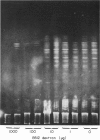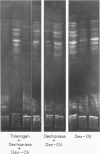Abstract
A direct comparison was made between thymus-dependent (TD) and thymus-independent (TI) responses in mice tolerized for (1 leads to 6) glycosyl determinants by the injection of dextran B512. Long-lasting B-cell tolerance by dextran was reversed when mice were treated with dextranase in vivo. Complete or partial reversion of tolerance with the enzyme was invariably obtained for the TI response but the TD component proved to be more resistant and dependent on the immunogen used to test the reversion. The uniformity of the spectrotype in BALB/c mice, even under conditions of partial tolerance, permitted the analysis by isoelectric focussing of serum from tolerant mice treated with dextranase and immunized with TD dextran-ovalbumin. Results showed that, with one single exception, mice thus treated produced spectrotypes no different from the pattern normally found in immune animals. The results presented suggest that at least some alpha(1 leads to 6) specific B cells, both TD and TI, persist in tolerized mice for at least 2 weeks after tolerance induction and they do not support the concept of clonal elimination for either TI or TD responses in adult mice.
Full text
PDF










Images in this article
Selected References
These references are in PubMed. This may not be the complete list of references from this article.
- Del Guercio P. Effect of adjuvants on the antibody response to a hapten on a thymus-independent carrier. Nat New Biol. 1972 Aug 16;238(85):213–215. doi: 10.1038/newbio238213a0. [DOI] [PubMed] [Google Scholar]
- Fernandez C., Möller G. Irreversible immunological tolerance to thymus-independent antigens is restricted to the clone of B cells having both Ig and PBA receptors for the tolerogen. Scand J Immunol. 1978;7(2):137–144. doi: 10.1111/j.1365-3083.1978.tb00436.x. [DOI] [PubMed] [Google Scholar]
- Fraker P. J., Speck J. C., Jr Protein and cell membrane iodinations with a sparingly soluble chloroamide, 1,3,4,6-tetrachloro-3a,6a-diphrenylglycoluril. Biochem Biophys Res Commun. 1978 Feb 28;80(4):849–857. doi: 10.1016/0006-291x(78)91322-0. [DOI] [PubMed] [Google Scholar]
- Howard J. G., Courtenay B. M. Influence of molecular structure on the tolerogenicity of bacterial dextrans. II. The alpha1--3-linked epitope of dextran B1355. Immunology. 1975 Oct;29(4):599–610. [PMC free article] [PubMed] [Google Scholar]
- Howard J. G., Vicari G., Courtenay B. M. Influence of molecular structure on the tolerogenicity of bacterial dextrans. I. The alpha1--6-linked epitope of dextran B512. Immunology. 1975 Oct;29(4):585–597. [PMC free article] [PubMed] [Google Scholar]
- Klaus G. G., Humphrey J. H. B cell tolerance induced by polymeric antigens. I. Comparison of the dose and epitope density requirements for inactivation of primed and unprimed B cells in vivo. Eur J Immunol. 1976 Jun;5(6):361–365. doi: 10.1002/eji.1830050602. [DOI] [PubMed] [Google Scholar]
- Miranda J. J. Studies on immunological paralysis. IX. The immunogenicity and tolerogenicity of levan (polyfructose) in mice. Immunology. 1972 Dec;23(6):829–842. [PMC free article] [PubMed] [Google Scholar]
- Moreno C., Hale C., Hewett R., Cussell D. Characteristics of the T-dependent alpha(1 leads to 6) glucosyl (dextran) antibody response induced in mice with isomaltohexaose coupled to chicken gamma-globulin. Eur J Immunol. 1979 Nov;9(11):916–919. doi: 10.1002/eji.1830091116. [DOI] [PubMed] [Google Scholar]
- Moreno C., Hale C., Ivanyi L. The mitogenic, immunogenic and tolerogenic properties of dextrans and levans. Lack of correlation according to differences of molecular structure and size. Immunology. 1977 Aug;33(2):261–267. [PMC free article] [PubMed] [Google Scholar]
- Möller G., Fernandez C. Immunological tolerance to the thymus-independent antigen dextran can be abrogated by thymus-dependent dextran conjugates: evidence against clonal deletion as the mechanism of tolerance induction. Scand J Immunol. 1978;8(1):29–37. doi: 10.1111/j.1365-3083.1978.tb00493.x. [DOI] [PubMed] [Google Scholar]
- Nossal G. J., Pike B. L. Clonal anergy: persistence in tolerant mice of antigen-binding B lymphocytes incapable of responding to antigen or mitogen. Proc Natl Acad Sci U S A. 1980 Mar;77(3):1602–1606. doi: 10.1073/pnas.77.3.1602. [DOI] [PMC free article] [PubMed] [Google Scholar]
- Ovary Z., Caiazza S. S., Kojima S. PCA reactions with mouse antibodies in mice and rats. Int Arch Allergy Appl Immunol. 1975;48(1):16–21. doi: 10.1159/000231289. [DOI] [PubMed] [Google Scholar]
- Richter W., Kågedal L. Preparation of dextran-protein conjugates and studies of their immunogenicity. Int Arch Allergy Appl Immunol. 1972;42(6):885–902. doi: 10.1159/000230665. [DOI] [PubMed] [Google Scholar]
- Shand F. L., Howard J. G. Induction in vitro of reversible immunosuppression and inhibition of B cell receptor regeneration by defined metabolites of cyclophosphamide. Eur J Immunol. 1979 Jan;9(1):17–21. doi: 10.1002/eji.1830090105. [DOI] [PubMed] [Google Scholar]
- Svensson S., Vicari G., Wilkinson S. An improved method for synthesising omega-stearoyldextran for the detection of plaque forming cells specific for the alpha-(1 replaces 6) determinant. J Immunol Methods. 1976;9(3-4):315–321. doi: 10.1016/0022-1759(76)90206-4. [DOI] [PubMed] [Google Scholar]
- Venkataraman M., Scott D. W. Cellular events in tolerance. VIII. Analysis of the proliferative capacity of antigen-binding cells isolated from normal or tolerant spleens. J Immunol. 1980 Feb;124(2):607–610. [PubMed] [Google Scholar]




